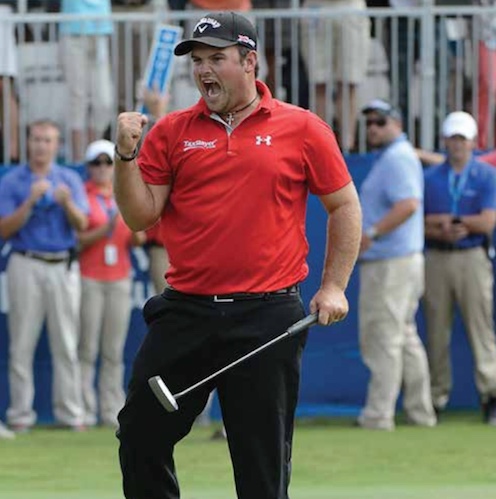
A reflection on the 2013 Wyndham Championship playoff
As the August twilight was about to descend on the lush fairways of Sedgefield Country Club on a soggy Sunday afternoon in 2013, little did the faithful who had remained for the Wyndham Championship playoff realize: They were about to witness the writing of the first draft of history.
That Sunday conjured snapshots from the first four years of the golf tournament’s forebear, the Greater Greensboro Open, when then-fledgling professionals Sam Snead, Ben Hogan, and Byron Nelson jump-started their illustrious careers on the very same soil.
No one then dreamed that the trio would later rule the PGA Tour and wind up as hall-of- famers, just as precious few in the late summer of 2013 realized that they were seeing authentic stardom in the making.
One of the contenders in the 2013 sudden-death playoff was still a teenager; the other had just turned 23. Both had been two-time participants in Greensboro’s American Junior Golf Association tournament, recently renamed the Haas Family Invitational.
But what they produced was a finish that is bound to earn legendary status as the years speed by. Barely three years later, the then-teenager, Jordan Spieth, has been ranked No. 1 in the world and has won both the Masters and the U.S. Open. The man who beat him, Patrick Reed, is closing in on a top-10 world ranking. So what else was so great about that playoff? The shot. The shot.
Looking Back
But that’s getting a little ahead of the story of the Wyndham Championship playoffs.
Most of the 15 earlier ones had their moments to remember. Two of Snead’s eight GGO victories came in playoffs, and he let another slip away when Earl Stewart beat him and Art Wall; and Doug Ford did the same in one that lasted 19 holes.
In 1972, George Archer had already packed his clubs in his car for the trip to the Masters when Arnold Palmer triple-bogeyed away a two-shot lead with three holes to play, plopping Archer and Tommy Aaron into an unexpected overtime that Archer won with a par.
Along the way there were also such notable playoff winners as Julius Boros, Gene Littler, Sandy Lyle, Ryan Moore, and Rocco Mediate, and such not-so-notable winners as Bud Allin, Trevor Dodd, and Frank Nobilo, the latter now a Golf Channel analyst. But the shot is what they will still be writing about when the tournament turns 100 or so — that and the two young lions who appear destined to become hall-of-famers. Turns out there was more than a little drama before Reed and Spieth got to the decisive second hole of the playoff in 2013. The final round of regulation had pretty much belonged to them as Spieth bested Reed by a stroke, 65 to 66, in the wake of overnight rains and an early morning storm that delayed play for three hours. And then came the real stuff.
Play-By-Play
On the first extra hole, Sedgefield’s par- four 18th, Spieth drove into the woods on the left and had to play a safety shot back into the fairway. Meantime, Reed split the middle with a textbook tee ball, and after Spieth put his third on the green, a good 26 feet from the pin, Reed hit another perfect one, leaving him maybe seven feet for a possible winning birdie.
But not so fast. Spieth, whose heroics with the putter have since become legendary around the world, curled in the putt with a good two-foot break. Par. Reed, perhaps a bit shaken, missed his birdie try and off they went to the 10th tee.
This time it was Spieth who hit the perfect tee shot, right down the middle of the uphill par four, and Reed found the trouble. Big trouble, it first appeared. Out of bounds in the trees to the right, someone signaled. As Reed later recounted, he was in shock. “My heart sank,” he says, but then came a turn of events that in the end saved the day. “All of a sudden,” he says, “three or four other people started running out on the fairway and gave me the safe signal.”
Cut to the chase. Though just 150 yards or so from the green and inbounds, his ball was, as they often say, in jail. There was no way he could reach the green, right? Wrong. With Spieth already on the green in two and within good (10 feet) birdie range, Reed smacked a three-quarter 7-iron under an overhanging tree limb, straight as a string, and it stopped seven feet below the hole.
The shot. Of a lifetime for Reed, as it turned out. Spieth was the one a bit spooked this time, and his birdie attempt lipped out. Reed’s was dead center for a shot that earned him his first PGA Tour victory, and a certain place for him and Spieth in the storied history of the venerable old tournament a hearty band of young businessmen dreamed up eight decades ago.